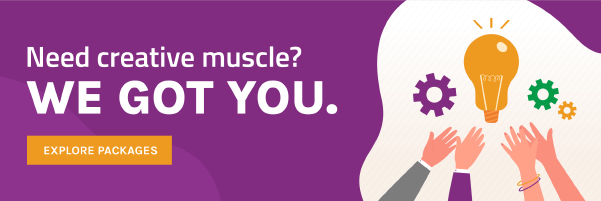Creativity 101: A Complete Guide to Brainstorming

“Let’s brainstorm this.” More often than not, this statement is something you and your team have heard when you need to generate ideas and share knowledge for meetings such as quarterly business reviews (QBRs) and annual joint plannings (AJPs).
Brainstorming is the collaborative effort among individuals to think freely and gather ideas, but how do you brainstorm effectively? It’s simple: Unleash your creativity. With brainstorming and creativity working hand in hand, you also improve the quality of your discussions in meetings, planning sessions, and reviews.
Getting your creative juices flowing
If you're trying to come up with fresh ideas only to find that the creative well has dried up, don't worry. Even the most creative minds in the world wrestle with this dilemma. The trick is to familiarize yourself with different strategies to get those creative juices flowing again. Here are a few for you to consider:
- Be open to new experiences — When you open yourself up to new experiences, you introduce your mind to new concepts that can grow into creative ideas. Openness to experience, as defined by Psychology Today, is “the drive to explore novel aspects of human experience and the willingness to consider perspectives different than your own.”
Imagine being stuck in a box your whole life. That’s what it’s like to keep yourself from having new experiences, which then keeps you from generating new creative ideas. - Be persistent — Creativity or inspiration doesn’t magically strike out of nowhere. Creative minds need to embrace persistence and continuously work to produce new ideas.
This means continuously committing to goals with or without immediate rewards. Don’t just sit there and wait for ideas; get up and get them. - Allot time to practice creativity and find inspiration — Just like getting up to get new ideas, it’s also important that you make time for creativity. Devote time for creative activities where you can practice, learn, and create.
Science has proven that pursuing a creative hobby can help your brain “fire new neural pathways,” as explained by Mother Untitled, allowing you to become a better problem solver. - Explore various solutions — The next time a problem arises, whether at work, at home, or in your personal life, try exploring multiple solutions. While your first idea may be good, try to allot room for other solutions and ways to approach the situation.
You can try problem-solving strategies that will exercise both your problem-solving and creativity skills. - Challenge yourself — Who doesn’t love a good challenge—especially one that makes you a better thinker? When you’ve developed creative skills, allow yourself to go one step higher. Challenge yourself to enhance what you already know.
Go for more difficult approaches, do something new, and try not to go back to what you’ve already mastered in the past. - Use mind maps and flowcharts — If you’re a visual person, this may be one of the most effective tips. A mind map is a diagram that represents concepts, words, and tasks linked to a central subject. With mind maps, you don’t have to worry about structure. A flowchart, on the other hand, is a graphical representation of a certain process.
Mind maps can show you how ideas are linked, while flowcharts allow you to visualize a final output. - Keep a creativity journal — A creativity journal can help you track the ideas you come up with. It’s also a great way to look back on what you’ve accomplished and get inspiration when you’re solving a new problem.
- Explore alternative scenarios — Just like flowcharts, situations don’t always have a linear path. Ask “What if?” questions and consider each possible scenario of the situation. Preparing yourself for these alternatives will help you come up with creative solutions.
Try the “six hats” technique where you can look at a situation or problem from six different perspectives:
- Black hat — Look at it negatively. Which elements of this solution could fail?
- Blue hat — Look at it broadly. What’s the most effective overall solution?
- Green hat — Look at it creatively. What are some alternative solutions or ideas?
- Red hat — Look at it emotionally. How do you feel?
- White hat — Look at it objectively. What are the facts?
- Yellow hat — Look at it positively. Which elements of this solution could work?
- Don’t self-reject — Developing creative skills means reframing self-criticism and embracing a mindset that prioritizes progress over perfection.
Negative thoughts can occur to anyone, but it’s important to make an active effort to challenge negativity and focus on realistic steps you can take to achieve what you set out to do.

Photo by fauxels from Pexels
Managing your creative brainstorming session
In any brainstorming session, there will always be varying—and even contradicting—ideas. This can be solved through proper management and methods that will get everyone on the same page.
- Know the problem — Define the problem that your session plans to address. Examples of problems or questions are “How do we improve our sales?” and “How can we make our products stand out?”
By making the problem clear to everyone involved, you encourage your participants to take a targeted approach to brainstorm solutions. - Make the context and definitions clear — Ask yourself what the participants already know and what else needs clarification. Gather whatever additional information they’ll need and present it during the session.
Additionally, make sure that everyone is on the same page when it comes to definitions of key terms. For example, if the question is “How can we make our products stand out?”, how do you define “standing out”? Do you want them to stand out visually? Do you want them to have new features? Or are you talking about how to differentiate your product from the competition? Make the context of the question clear to all. - Invite the necessary people — The participants of the session should be people who are affected by the problem question.
We recommend inviting both experts and non-experts on the topic. This will allow the session to have a broad range of ideas. - Set the agenda — Just like any aspect of the discussion, the agenda should be clear.
Setting your brainstorming session agenda includes setting out the problem question, boundaries of the discussion, context, and definitions. - Hold the session — Once you’re ready to hold your brainstorming session, you can try out some of the techniques that we’ll be mentioning later in this blog. Remember that using techniques is beneficial because these provide structure to the session.
And of course, at the end of your brainstorming session, explain the next steps. Make sure the participants receive a summary of the top ideas.
Choosing your ideation technique
Now that we’ve covered the essential aspects of brainstorming, here are 13 ideation session techniques to stimulate your team’s creativity for a productive brainstorming session:
- Brainwriting — Ask the group members to each get a piece of paper where they can write down their brainstorming session ideas. There are several ways to do brainwriting, but the basic method is:
- Each group member writes down their idea in response to the problem or question.
- They pass their paper to the person next to them. That person will then add to that idea. This will go on so that each piece of paper reaches every member.
- When the pieces of paper have made a full round and have reached the original owners, the group members share their ideas.
- Collaborative brainwriting — Similar to brainwriting, collaborative brainwriting involves getting everyone’s ideas, but it won’t happen at the same time.
One person will begin by writing a question or problem on something that can be seen by everyone, like a whiteboard. Tell the team that they have around a week to write down their ideas. After that, the team can get together and discuss. - Mind mapping — Mind mapping can be done alone or as a group. Begin by writing your goal or challenge then think of related issues.
Make connections by adding related brainstorming session ideas to the map so you could see how these ideas and concepts relate and connect.
- Round robin — In the round-robin method, participants are arranged in a circle. Once the group has identified their theme or question for discussion, one participant starts by offering a single thought. This can be done out loud or through writing.
When the participant has finished contributing, the person next to them adds another point or idea. This goes on in clockwise motion, with each participant speaking/writing a single idea, until a full circle has been completed. The session ends with a group discussion. - Image method — For this method, team members close their eyes and talk about what they want to create (e.g., a shirt design that kids will love). Each person in the group sets that goal in their mind and closes their eyes as they create a vivid image based on the goal. They then add to the picture based on the given direction (e.g., “Imagine the shirt being worn by a kid in school,” “Picture the shirt in a happy color”).
Ask the team members to share their marketing brainstorming ideas. Take note of what they share and ask the members to layer additional ideas. - Stepladder — Start by sharing the challenge with everyone in the room. Next, everyone except two people steps out of the room. The pair is given a set amount of time to discuss ideas.
After that, one more person enters the room and shares their ideas before the pair shares theirs. A new person enters every few minutes and repeats the process. Once everyone is back in the room and has shared their ideas, the group can discuss all the good ideas and identify the ones to keep. - Charrette — All group members must have a few sheets of paper and a pen. Write the goal or the challenge on the board.
To start the charrette process, each person sketches their ideas for five minutes. After that, each person gets two minutes to share their ideas and explain the reasoning. Other group members may ask questions to the person sharing. At the end of the session, collect the pieces of paper and use the ideas to come up with a solution. - Figure — As a group, think of a fictional character, a historical figure, or a famous person who’s not in the room.
Ask yourselves: What would that person do to solve this problem? What would work and what would backfire? Discuss as a group, and you might come up with a lot of creative ideas. - Trigger — The trigger method begins with a trigger that encourages creative thinking. Start with an open-ended question or a proactive statement, such as “Our target market seems to love it when…” or “Our customers need to understand that…”
Try to get everyone’s ideas and work from there. - Role — Group members are asked to see themselves in the role of someone related to the goal, such as a customer. Once the members know the role, they act out a scene wherein each member plays that role.
Look at the problem from that role’s point of view. What would they want to know? What would they be interested in? - The 5 whys — This method simply involves continuously asking “why.” Start with the problem, such as “Our newest ice cream flavor was not a hit.” Then, ask why. The answer could be, “Our customers don’t like the taste of that fruit.” Keep asking why until you get to the root of the issue. You may get there in fewer or more than five whys, which is totally fine.
When the group has finished going through the five whys, discuss the findings and what’s next. - Brain netting — This is an effective way for remote teams to brainstorm. Use a tool where people can share and collaborate, such as Google Docs. Each member then contributes ideas on their own time.
Set a deadline and a meeting where all members discuss the ideas in real-time. - Gap filling — The team begins with a statement of where they are and another statement of where they want to be. From there, the group members share ideas on how to get from point A to point B.
Keeping your session focused
Creative brainstorming sessions tend to generate a plethora of ideas. While not a bad problem to have, too many ideas can derail the point of your session.
Luckily, a helpful Entrepreneurial Operating System (EOS) technique can help with sorting through these ideas so you identify the ones that keep your session focused: Keep, kill, and combine.
- Keep — Identify the non-negotiables. What are the ideas from the session that HAVE to be there—no excuses?
- Kill — Know which ideas can be listed as important but not essential. Which ones can be kept on the back burner?
- Combine — Identify similar prospects. Which ones can be paired or combined?
Brainstorming is an effective way to develop creative ideas and solutions.
Whether it’s your first or hundredth time conducting a brainstorming session, we hope these creative brainstorming techniques help you and your team as you generate ideas and solve problems.
Allow our team of professional brainstormers to come up with ideas with you. Check out our packages here.








Comments